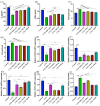A Docosahexaenoic Acid Derivative (N-Benzyl Docosahexaenamide) as a Potential Therapeutic Candidate for Treatment of Ovarian Injury in the Mouse Model
- PMID: 35566104
- PMCID: PMC9102315
- DOI: 10.3390/molecules27092754
A Docosahexaenoic Acid Derivative (N-Benzyl Docosahexaenamide) as a Potential Therapeutic Candidate for Treatment of Ovarian Injury in the Mouse Model
Abstract
Commonly used clinical chemotherapy drugs, such as cyclophosphamide (CTX), may cause injury to the ovaries. Hormone therapies can reduce the ovarian injury risk; however, they do not achieve the desired effect and have obvious side effects. Therefore, it is necessary to find a potential therapeutic candidate for ovarian injury after chemotherapy. N-Benzyl docosahexaenamide (NB-DHA) is a docosahexaenoic acid derivative. It was recently identified as the specific macamide with a high degree of unsaturation in maca (Lepidium meyenii). In this study, the purified NB-DHA was administered intragastrically to the mice with CTX-induced ovarian injury at three dose levels. Blood and tissue samples were collected to assess the regulation of NB-DHA on ovarian function. The results indicated that NB-DHA was effective in improving the disorder of estrous cycle, and the CTX+NB-H group can be recovered to normal levels. NB-DHA also significantly increased the number of primordial follicles, especially in the CTX+NB-M and CTX+NB-H groups. Follicle-stimulating hormone and luteinizing hormone levels in all treatment groups and estradiol levels in the CTX+NB-H group returned to normal. mRNA expression of ovarian development-related genes was positive regulated. The proportion of granulosa cell apoptosis decreased significantly, especially in the CTX+NB-H group. The expression of anti-Müllerian hormone and follicle-stimulating hormone receptor significantly increased in ovarian tissues after NB-DHA treatment. NB-DHA may be a promising agent for treating ovarian injury.
Keywords: cyclophosphamide; docosahexaenoic acids; granulosa cells; macamide; ovary.
Conflict of interest statement
The authors declare no conflict of interest.
Figures





Similar articles
-
A newly identified polyunsaturated macamide alleviates dextran sulfate sodium-induced colitis in mice.Fitoterapia. 2021 Jul;152:104916. doi: 10.1016/j.fitote.2021.104916. Epub 2021 May 1. Fitoterapia. 2021. PMID: 33945874
-
Ceramide-1-phosphate has protective properties against cyclophosphamide-induced ovarian damage in a mice model of premature ovarian failure.Hum Reprod. 2018 May 1;33(5):844-859. doi: 10.1093/humrep/dey045. Hum Reprod. 2018. PMID: 29534229
-
[Effects of gonadotropin releasing hormone analogues on chemotherapy-induced ovarian function damage in rats].Zhonghua Fu Chan Ke Za Zhi. 2007 Aug;42(8):546-50. Zhonghua Fu Chan Ke Za Zhi. 2007. PMID: 17983495 Chinese.
-
Interactions between androgens, FSH, anti-Müllerian hormone and estradiol during folliculogenesis in the human normal and polycystic ovary.Hum Reprod Update. 2016 Nov;22(6):709-724. doi: 10.1093/humupd/dmw027. Epub 2016 Aug 27. Hum Reprod Update. 2016. PMID: 27566840 Review.
-
A putative role for anti-Müllerian hormone (AMH) in optimising ovarian reserve expenditure.J Endocrinol. 2017 Apr;233(1):R1-R13. doi: 10.1530/JOE-16-0522. Epub 2017 Jan 27. J Endocrinol. 2017. PMID: 28130407 Review.
Cited by
-
Natural Products Chemistry: Advances in Synthetic, Analytical and Bioactivity Studies.Molecules. 2023 Jul 22;28(14):5577. doi: 10.3390/molecules28145577. Molecules. 2023. PMID: 37513449 Free PMC article.
-
Comparison the therapeutic effects of bone marrow CD144+ endothelial cells and CD146+ mesenchymal stem cells in POF rats.Bioimpacts. 2023;13(6):495-504. doi: 10.34172/bi.2023.27781. Epub 2023 Jul 29. Bioimpacts. 2023. PMID: 38022384 Free PMC article.
-
The Efficient Synthesis and Anti-Fatigue Activity Evaluation of Macamides: The Unique Bioactive Compounds in Maca.Molecules. 2023 May 7;28(9):3943. doi: 10.3390/molecules28093943. Molecules. 2023. PMID: 37175353 Free PMC article.
References
-
- Taghizadeh M., Asemi Z., Keshavarz S.A., Jafarnejad S. The Effect of Omega-3 Fatty Acids, EPA, and/or DHA on Male Infertility: A Systematic Review and Meta-analysis. J. Diet Suppl. 2019;16:245–256. - PubMed
MeSH terms
Substances
Grants and funding
LinkOut - more resources
Full Text Sources

